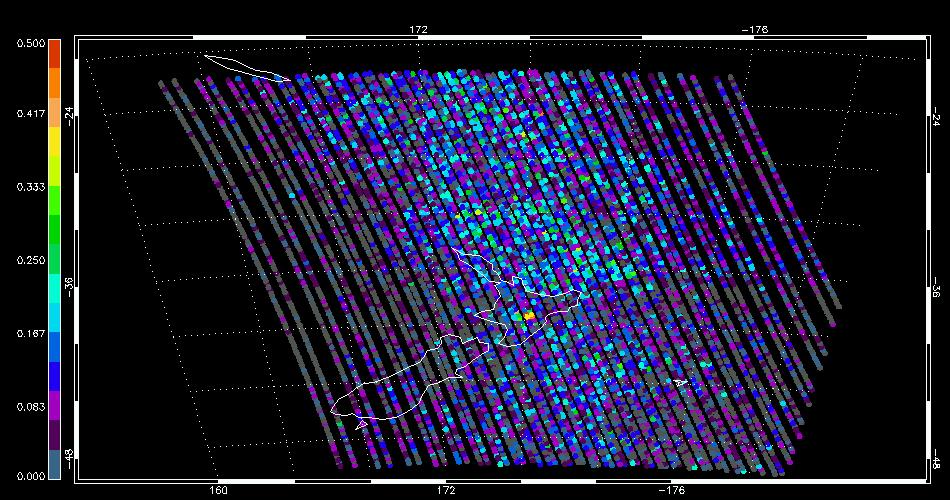Ash: Difference between revisions
(Created page with "Explosive volcanic eruptions typically eject hot mixtures of fragmented rock (tephra or ash) and volcanic gases into the atmosphere to form a volcanic plume. The commonest for...") |
No edit summary |
||
| Line 59: | Line 59: | ||
the same extent. The ash signature depends on the composition and size | the same extent. The ash signature depends on the composition and size | ||
distribution of ash particles. | distribution of ash particles. | ||
[[File:Prova newzeal-2012112209.jpg|frame|center|IASI SO<sub>2</sub> anomaly flag for X November 2012 at XX.XX GMT. ''Credit: Dr Elisa Carboni'']] | |||
Figure 1 | |||
shows an example of different extinction | |||
coefficients computed using the same | |||
size-distribution (with an effective radius | |||
of 2 m) and different refractive indexes. | |||
Revision as of 15:39, 14 December 2012
Explosive volcanic eruptions typically eject hot mixtures of fragmented rock (tephra or ash) and volcanic gases into the atmosphere to form a volcanic plume. The commonest forms of magma can be divided into three broad types based on their chemical composition:
1. Basaltic magma (SiO2 45-55 wt%, high in Fe, Mg, Ca, low in K, Na)
2. Andesitic magma (SiO2 55-65 wt%, intermediate in Fe, Mg, Ca, Na, K)
3. Rhyolitic magma (SiO2 65-75%, low in Fe, Mg, Ca, high in K, Na)
Changes in style of activity are common during eruptions, with explosive eruptions being particularly favoured by high (magmatic) gas content, and high melt viscosity (andesitic to rhyolitic magmas), or by the presence of external water (e.g. Sheridan and Wohletz, 1983; Scandone et al., 2007). Volcanic plumes formed by explosive eruptions are mixtures of gas, quenched and fragmented silicate material (tephra) and other aerosol particles derived from both the magmatic emissions and background air (e.g. Durant et al., 2010; Ilyinskaya et al., 2010; Oppenheimer et al 2010). The smaller solid particles (radii < 2 mm) are referred to as volcanic ash. Component and morphological analyses of the erupted ash, and comparison of these data with those from other monitoring techniques, demonstrates a clear relationship between ash features and styles of explosive activity (e.g. Heiken and Wohletz, 1985; Martin et al., 2008; Rust and Cashman, 2011, Taddeucci et al. 2004). The effects of airborne ash include:
Climate: Injection of volcanic ash into the stratosphere and troposphere influences the Earth’s radiation balance by interacting with both solar and thermal radiation as a function of the ash’s optical properties (IPCC 2007). In the troposphere volcanic aerosols indirectly modify climate by acting as cloud condensation nuclei. This happens over the range of volcanic activity from quiescent degassing (Yuan et al., 2011) to large volcanic eruption plumes.
Aviation:Aviation: Before March 2010 the Civil Aviation Authority did not permit civil aircraft to fly in the presence of volcanic ash. Following the 2010 Eyjafjallajökull eruption this zero-tolerance approach was changed to permit flights within ash concentrations less than 2 10-3 g cm-3 (CAA, 2010).
Human Health: High levels of respirable ash (particle radius less than 5 μm) in the air are not yet known to result in serious injury or disease from inhalation. However acute respiratory symptoms are commonly reported by people during and after ash falls (Blong, 1984) Heavy ash fall may result in the collapse of roofs under the weight of ash and this can be deadly for people within buildings. The deposition of volcanic ash can increase trace metal (iron) concentrations in the local environment (ocean), especially following explosive eruptions (Martin et al., 2009), and this can increase the productivity of phytoplankton in areas with limited nutrients (Jones and Gislason, 2008; Gabrielli et al., 2008).
Heavy ash fall may result in the collapse of roofs under the weight of ash and this can be deadly for people within buildings. The deposition of volcanic ash can increase trace metal (iron) concentrations in the local environment (ocean), especially following explosive eruptions (Martin et al., 2009), and this can increase the productivity of phytoplankton in areas with limited nutrients (Jones and Gislason, 2008; Gabrielli et al., 2008).
Quantifying the effects of ash requires knowledge of ash loading, composition, morphology and size, as well as the physical dimensions and location of the ash plume. In addition, tephra from explosive volcanic eruptions holds information about magma dynamics in the critical zone where fragmentation occurs and eruption style is decided.
The infrared (IR) transmission or emission spectra of volcanic plumes shows a rapid variation with wavelength due to absorption lines from atmospheric and volcanic gases as well as broad scale features principally due to particulate absorption. While the gas lines have provided important insights into volcanic processes (Burton et al., 2001, 2003; Oppenheimer et al., 2006; Edmonds, 2003, Sawyer et al 2008) the ash features have not been analysed to the same extent. The ash signature depends on the composition and size distribution of ash particles.
Figure 1 shows an example of different extinction coefficients computed using the same size-distribution (with an effective radius of 2 m) and different refractive indexes.
